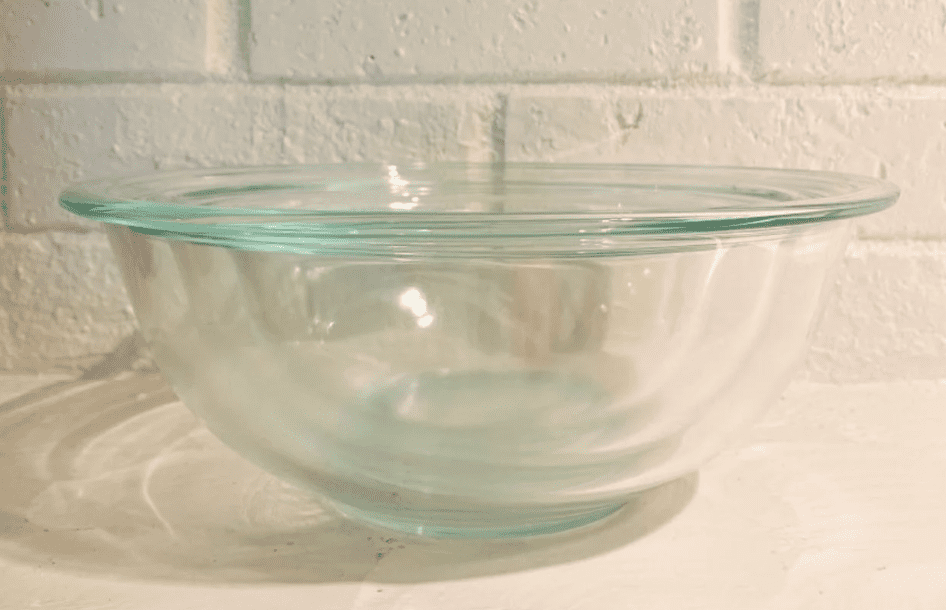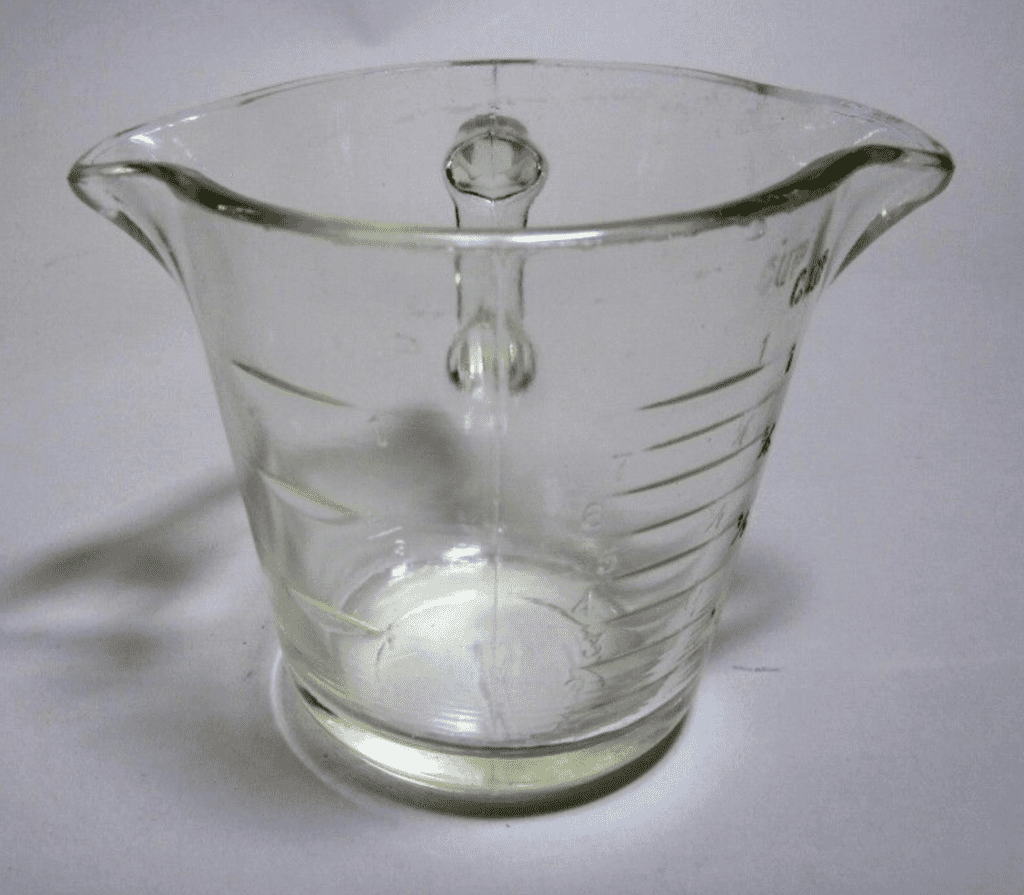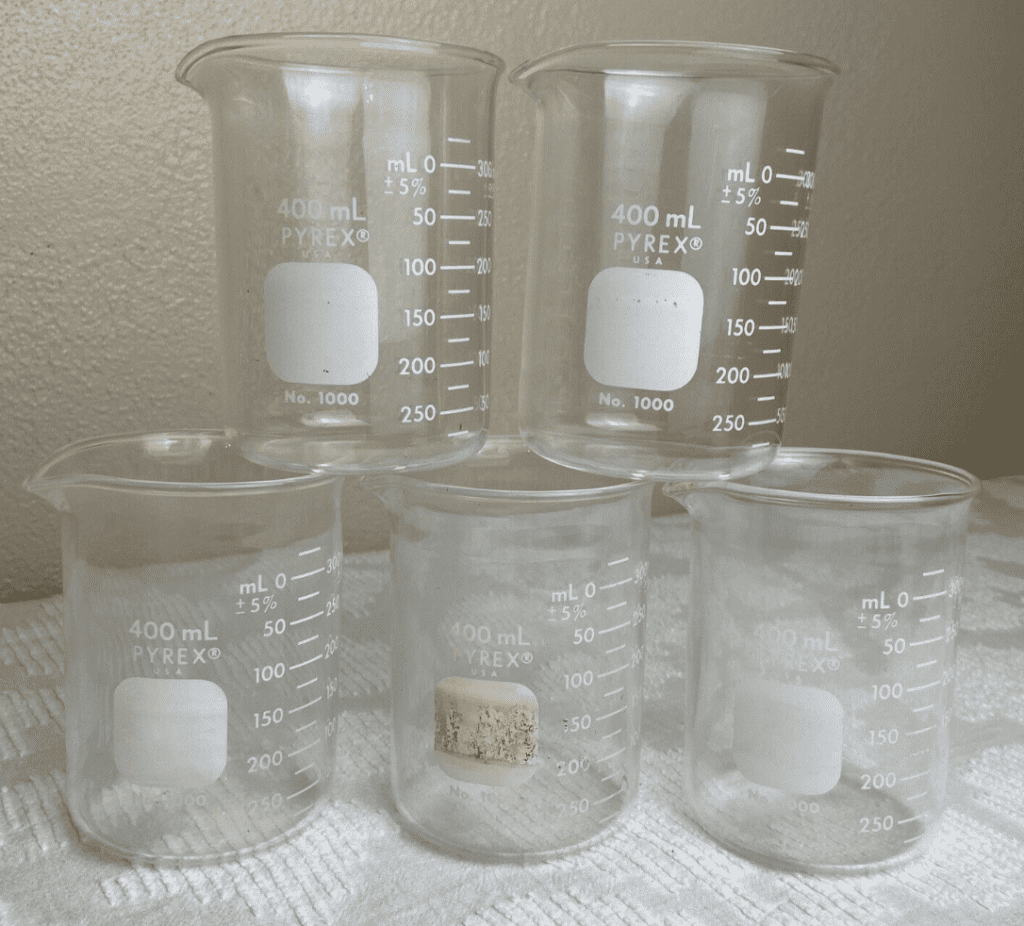Although Pyrex is glass, there are significant differences that set this type of glass apart from others. Normal glass is not as resilient as Pyrex due to the manufacturing process and chemical composition of Pyrex.
Pyrex is glass made from borosilicate or soda-ash glass with boron added depending on country of origin. Unlike normal glass, Pyrex has an unbreakable quality and can handle extreme temperature changes. Pyrex is commonly used in cookware or bakeware and has been preferred by cooks for years. It is also used in chemical instruments and thermometers.
In this article, we’ll explore the differences between normal types of glass and Pyrex and provide you with an overview of the characteristics that make Pyrex glass unique.

What Is the Difference Between Pyrex and Normal Glass?
First, you’ll need to dive into the history of Pyrex glass to gain a better understanding of the difference between the two. The road to creating Pyrex began in 1908 when Eugene Sullivan developed Nonex (borosilicate low-expansion glass) when he was a director of research at Corning Glass Works. Then, Jesse Littleton of Corning gave his wife Bessie a casserole dish made from a cut version of Nonex.
Consequently, borosilicate’s usefulness as cookware was discovered. Nonex had lead in its composition, so Corning removed the lead and then created the product we know as Pyrex. In 1915, Pyrex was produced in America and marketed as an alternative to Duran glass which was the first borosilicate glass created in 1893. (Source) Pyrex was named after combining the terms “pie” and “Nonex”.
The first line from 1915 included 12 pieces which featured both pie plates and a loaf pan. (Source) Early products included “casserole dishes, as well as pie plates, egg dishes, custard cups, loaf pans, oval baking dishes, cut-glass teapots and engraved dishes”. (Source) A popular item that Pyrex is known for, the glass measuring cup, debuted in 1925. This measuring cup is different from the one that we know and love today. It had two spouts, one on each side, and a handle in between.

Today’s Pyrex glass is manufactured through a special process that includes tempering and mainly used for cooking (amongst other uses), while normal glass is typically used for architectural purposes. (Source). Tempered glass is a more resilient type of glass that will not shatter when it breaks. Instead, it will break into small cubes, ensuring safety. (Source)
Pyrex can be used for cooking in ways that normal glass cannot be used. For example, original Pyrex will typically withstand sudden temperature changes, such as pouring cold milk into a Pyrex bowl followed by placing it into a hot oven. Pyrex is heat resistant up to a temperature of 425 degrees. Keep in mind that modern Pyrex will behave differently when subjected to extreme temperature changes.
And, if Pyrex is frozen, you will not want to immediately move it to a significantly hotter temperature because, like normal glass, it will crack. The dish will need to be thawed first and vice versa—going from a hot temperature to a cold one will also cause damage. First, let the Pyrex dish come to room temperature. Pyrex can also be used directly on a stovetop, but take care to heat up the dish slowly instead of at a rapid pace.
Pyrex is also used to create various tools that are used when working with chemicals—beakers and Erlenmeyer flasks for example—for use in industrial equipment, telescopes, and thermometers amongst other things. The version of Pyrex that is borosilicate is slow to expand, making it a choice material for astronomy optics use.

One of the most well-known uses of Pyrex in astronomy is the creation of the telescope mirror for the Palomar Observatory project at California Institute of Technology. (Source) Previous experiments with other types of glass could not endure the conditions needed to power the telescope (heat expansion, temperature fluctuations). It even took many attempts to develop the telescope mirror using Pyrex, but eventually, a 200-inch disk was created and is still being used to today to gaze at the stars and into outer space. (Source)
Pyrex is chemical resistant, unlike many other types of glass or plastic. Transparency is important when working with chemicals to gain a clear view and Pyrex is highly transparent. Pyrex also has a quality known as dimensional stability, meaning that it can retain its original dimensions better than normal glass and most other materials. (Source) In addition, Pyrex is very easy to clean as it is “dustproof, waterproof, corrosion proof”. (Source)
Along with these uses, Pyrex is a great choice as a collectable, especially patterned Pyrex. Vintage Pyrex was manufactured in a variety of patterns and colors starting in the 1950s, making vintage Pyrex from that era wonderful for display. Modern Pyrex typically is no longer produced in these fun patterns and colors so vintage Pyrex is especially sought after. However, you can still find some whimsical pieces of Pyrex, such as the Hello Kitty themed items. (Source)
Is Pyrex Glass Real Glass?
Pyrex is real glass but has a different composition and manufacturing process that is unique in comparison to other types of glass. Also, Pyrex is a trademarked name for this type of glassware. The increased content of borosilicate glass in Pyrex makes it much stronger than most glass. To answer the question, Pyrex glass is considered real glass.
Why Is Pyrex Glass Better?
Pyrex glass is better for the following reasons:
· Able to tolerate extreme temperature changes (within reason)
· Less likely to break as compared to typical glass
· Can be used in multiple ways for cooking (stove top, baking, mixing, etc.)
· Shatter resistant due to the tempering process in combination with the added borosilicate*
· Chemicals cannot permeate Pyrex glass, making it one of the best choices for use in chemical applications such as instruments in chemical laboratories
*There is some debate about the newer Pyrex composition. Some sources report that boron, the key ingredient in borosilicate glass, is added to the soda-lime composition while other sources report that modern American Pyrex is a soda-lime based glass without added boron. Make sure that you are fully aware of the type of Pyrex you are using in cooking.
Why Is Pyrex Glass Unbreakable?
Due to the composition of Pyrex glass, using either the modern tempered soda-lime composition with boron or the older borosilicate mixture, results in a glass that can withstand extreme temperatures as well as repeated use or being dropped on a hard surface multiple times. However, it is not entirely unbreakable.
Even Pyrex glass has its limitations. Also, there are pieces of Pyrex glass that are manufactured solely with tempered soda-lime glass, which can cause the piece to become susceptible to thermal shock, shattering with temperature changes. (Source)
These soda-lime pieces do not have the added boron that makes the glass virtually unbreakable. All Pyrex that is created for laboratory use is made from borosilicate glass in order to have all of the characteristics of traditional Pyrex: unbreakable, able to withstand extreme temperature changes, easily cleanable, and non-permeable.
Borosilicate Glass Vs Pyrex Glass
Pyrex glass was a borosilicate glass years ago in the United States. Today, European Pyrex is made from “pure sand (80%), soda (4%), Alumina (2.5%), and bore (13%)” which is still a borosilicate glass. (Source) During the manufacturing process, borosilicate Pyrex is melted to a temperature of roughly 1500 degrees Celsius. This allows the glass to be extra durable and able to withstand extreme temperatures and rough handling.
In years past, U.S. produced Pyrex was a true borosilicate glass, composed of “4.0% boron, 54.0% oxygen, 2.8% sodium, 1.1% aluminum, 37.7% silicon, and 0.3% potassium” (Source). During the 1980s, Pyrex was shifted to a soda-lime glass manufactured by Corning.
While European Pyrex is still made solely from borosilicate, Pyrex from the United States uses the newer soda-lime composition. Pyrex manufactured in the United States today will not be able to handle temperature changes as well as older Pyrex glass due to the changed composition from borosilicate to soda lime with added boron. The Pyrex brand was sold to World Kitchen in 1998 and consumer-grade Pyrex in the United States has the newer soda-lime composition only.
The differences between borosilicate glass and Pyrex glass chemical composition are shown in the table below:
At this point, you may be wondering how you can know the difference between borosilicate-based Pyrex and modern soda-lime Pyrex. There are a few ways that you can easily determine which type of Pyrex you have. (Source)
·Take a good look at your Pyrex: Does it have a greenish-blue hue when looking at the edge of the piece? If so, it is the newer soda-lime Pyrex. Older (or modern European) borosilicate-based Pyrex will be completely clear. Take precautions when using newer Pyrex as it cannot tolerate the extreme temperatures that older Pyrex can tolerate. For example, you won’t be able to move a dish straight from the refrigerator to a hot oven.
· Scratch Test: Try to scratch the Pyrex using a drill with a diamond bit. Depending on the hardness, you can determine if the piece is borosilicate-based or soda-lime based. Borosilicate Pyrex will be much harder to scratch than soda-lime based Pyrex.
· European Pyrex (for pieces produced past 1998 only): To find Pyrex with the former borosilicate-based composition, purchase a European piece of Pyrex. Vintage and antique Pyrex will already have this composition. You’ll also find vintage Pyrex in a variety of beautiful colors and patterns!
· Consider the age of your Pyrex: Is it older than 25 years? Then it is likely that your Pyrex was an original Corning-manufactured piece that was produced with the borosilicate composition, or the soda-lime composition with added boron.
· The scientific method: Borosilicate glass can be identified by its refractive index, 1.474 (Source) You can also immerse the glass with liquid that has a similar refractive index, like mineral oil. The glass will seem to disappear!
Is Borosilicate Glass Like Pyrex?
Pyrex is true borosilicate glass in some markets (UK). However, in the U.S. Pyrex is typically not true borosilicate glass in present times because it is made of a soda-lime composition with boron added. In other instances, Pyrex is made of soda-lime only, which will not be as resilient as older Pyrex and modern Pyrex with boron added. In addition, soda-lime tempered glass is known to better withstand sudden impact as opposed to borosilicate glass. Borosilicate glass is non-toxic.
When Pyrex was first created, all Pyrex was borosilicate glass. In recent years, there was some concern about Pyrex “exploding” due to the change in materials. (Source) This is likely due to a quick temperature change, called thermal shock. Keep in mind that Pyrex is no longer made by its original manufacturer and is a brand name, not a material.
After being acquired by Corning brand, Corning sold the Pyrex brand to World Kitchen in 1998. Since then, there have been discrepancies in the resilience of Pyrex. Some modern pieces may be tougher, and some may not. Also, it is difficult to determine which pieces will be more breakable than others. Using the guidelines above can help you determine this, but the best way to decide what type of Pyrex you have is to locate the manufacturer, especially in pieces produced after 1998.

Why did Pyrex get changed from the original composition to the new one? One reason is increased air pollution regulations. Also, a focus on reducing energy consumption helped contribute to the change. The new soda-lime composition doesn’t require as much energy to produce and can be recycled, making it a better choice for the environment. (Source)
Is Pyrex Better Than Glass?
It depends on the purpose the glass is used for. If the glass is to be used for extreme temperature changes (such as various cooking methods), you will want to choose Pyrex glass. If you are in search of a decorative glass, or for use as a glass container in room-temperature food storage or mixing, normal glass can be used for those purposes.

Most would consider Pyrex superior to regular glass due to its resilient qualities. Pyrex glass does not need to be treated as fragile compared to normal glass. It can withstand temperature changes, repeatedly being dropped, etc. Pyrex is a great choice for multiple uses, especially when needing to use glass instead of plastic.

